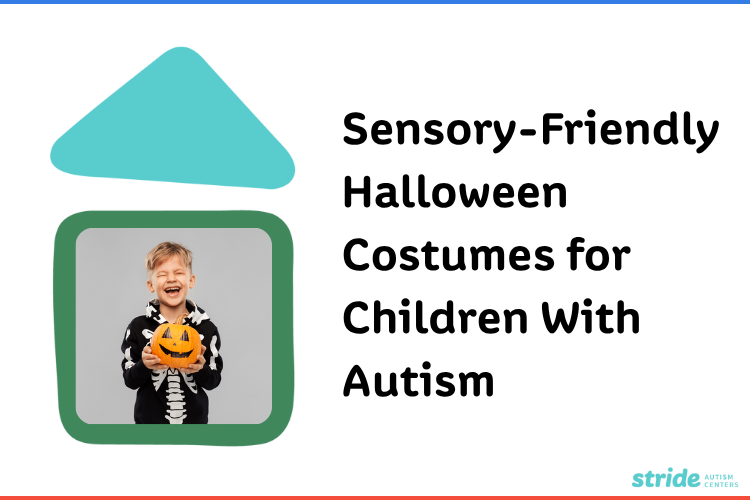We can remember the itchy, tight, noisy, or smelly Halloween costumes we wore while trick-or-treating in our childhood. While they were uncomfortable for us, they can be overwhelming for kids with autism, often leading to stress, meltdowns, or avoidance. Here’s a comprehensive guide to costume ideas and tips to help your child with autism have a safe, comfortable, and fun Halloween.
Why Sensory-Friendly Costumes Matter for Young Children With Autism
Halloween is typically filled with spooks and scares, and while this can be fun for some, it can be very overwhelming for your child with autism. Sensory issues are common for those on the autism spectrum and can include all five senses: sight, sound, taste, touch, and smell. Finding a comfortable costume is something you can control for your child on a night that is already unpredictable and loud, helping them feel safe, confident, and included.
What to Look for in a Sensory-Friendly Costume
Creativity is the best approach when looking for a sensory-friendly Halloween costume. Here are a few materials and details to keep in mind:
- Soft, breathable fabrics: For your child’s Halloween costume, look for soft, breathable, and nonirritating fabrics. Instead of scratchy materials like tulle or polyester, try to find cotton, bamboo, or other natural fibers. It’s also helpful to layer soft, familiar clothing under the costume so any itchy materials never directly touch your child’s skin.
- Tagless and seamless designs: Tags and seams on costumes are often itchy and uncomfortable. If the costume has a tag, cut it off and adjust seams as needed for a comfortable fit.
- Easy-on, easy-off features: When searching for costumes for children with autism, prioritize hook-and-loop fasteners, such as Velcro, or simple buttons. This way, you can easily remove the bothersome garment if necessary. Layering clothing beneath the costume is also helpful in these situations.
- Adjustable and customizable options: Many costumes come with adjustable features, such as an elastic waist or Velcro closures. Consider sizing based on your child’s needs and preferences and adjust accordingly.
- Avoid masks: Search for a costume that does not involve a mask that completely covers the face. These coverings can be stifling and may cause your child to panic.
Top Sensory-Friendly Halloween Costume Ideas for Ages 2-6
We’ve compiled a few store-bought or DIY costume ideas to use, but feel free to use your imagination for endless possibilities!
Store-Bought Options and Considerations
If your child wants a store-bought option or an official costume from their favorite franchise, here are a few places to start:
- Harry Potter characters: To transform into a student from Hogwarts, all your child needs is a long, flowy robe and an oversized scarf in their house colors. This iconic and comfortable costume is perfect for a magical, sensory-safe Halloween.
- Disney characters: Disney characters offer a wide range of costume options, from princesses to villains and more. Better yet, these costumes are often designed for easy on and off, with Velcro or button closures — and they rarely ever need masks!
- Animal onesies: A onesie costume is a cute and comfortable alternative. These one-piece costumes come in various animal types, including pandas, cats, dinosaurs, cows, and sharks.
DIY and Adaptable Costumes
If budgeting is a concern or you prefer to do your own thing, making your own costumes can be a fun craft to do with your child. Browse Pinterest to find ideas that use:
- Sweatshirts: A thrifted sweatshirt or one you already own makes a great base for a costume. Sew felt triangles on the back of a hoodie to be a dinosaur or yellow and black stripes on a crewneck to be a bumble bee — the opportunities are limitless.
- Everyday clothes: Gather clothes you already own or go to a thrift store to piece together an iconic outfit. For example, you can find an old cheerleading outfit and pair it with pom poms or wear a red and white striped shirt to be Waldo from Where’s Waldo.
- Themed pajamas: Every year around Halloween, many stores have a wide variety of themed pajamas. Wearing patterns ranging from spiders to witches, your child can trick or treat in comfort.
Preparing Your Child for Halloween: Tips for a Positive Experience
While every child’s needs are different, here are some general tips for making Halloween a positive experience for everyone:
- Practice wearing the costume: Suggest that your kiddo wear their costume around the house ahead of Halloween to get used to it. If they complain about any discomfort, you have time to tweak any design flaws.
- Experience Halloween decor beforehand: Before Halloween, you can expose your child to the Halloween decor in a department store. This controlled environment can offer a safe space for them to explore and experience everything on their terms.
- Create a code word or signal: Create a code word or signal with your child in case they feel overwhelmed and need a break. This way, you can know how they are feeling and respond quickly.
- Make your own traditions: If trick-or-treating is too much, stay close to home and make your own fun Halloween traditions. Hand out candy at your house, or go out to visit other loved ones in costume before Halloween.
Help Your Child Thrive Every Day With Stride Autism Centers
With Stride Autism Centers, we use applied behavior analysis (ABA) therapy programs to help children with autism function in overstimulating environments for Halloween and beyond. Together, we can craft a personalized care plan to help your child thrive.
Contact us to get started today.






